Eduard (Hasegawa) 1/48 Typhoon Ib
History:
Traditionally, the hallmark of a successful aircraft manufacturing company has been that future requirements should always be the concern of the Chief Designer and the project team. In other words, when the latest project has been accepted for production, its replacement should be on the drawing board. Sir Sydney Camm, Hawker Aircraft's Chief Designer and one of the true legends of aircraft design alongside Ed Heineman and Kelly Johnson, was already hard at work in the summer of 1937 on the Hurricane's replacement - to meet Air Ministry Spedification F.18/37 which called for a fighter with a top speed over 400 m.p.h. - when the first production model of that famous airplane had yet to fly.
The airplane was the Hawker Typhoon, the first all-metal airplane produced by Hawker Aircraft. Originally armed with 12 .303 machineguns, it was redesigned to carry the then-unheard-of armament of four 20mm cannon and was powered by the Napier Sabre, the first 2,000 h.p. engine. Ordered "off the drawing board" in 1939, the prototype Typhoon flew on February 24, 1940. It became the subject of a quantity production order to be assigned to Gloster Aircraft, since Hawkers was thoroughly committed to the Hurricane.
At the time the first prototype was rolled out in 1940, it was the biggest single-seat, single-engine fighter ever designed, with the heaviest armament any traditional fighter had ever carried, with the most powerful aero engine ever installed in an airframe. Unfortunately, not enough was known at the time of its design to prevent it being equipped with a wing too thick for what was really needed, which would always hold it back in fighter versus fighter performance. The exigencies of war would dictate that the airplane was committed to production too early in the development cycle, resulting in it acquiring a worse reputation with its pilots than any fighter that ever preceded it, a dangerous reputation that was fully deserved at the outset and would cost the lives of many young fighter pilots to resolve.
In the end, all the heartache would be justified, as it became the primary weapon of close air support alongside the P-47 Thunderbolt, covering the victorious Allied armies as they swept across northwestern Europe in the breakout from Normandy. As a killer of German armored vehicles, it would only be out-done by the Russian Sturmovik.
Flight testing quickly revealed the effects of compressibility, of which little was known at the time. The thick wing also resulted in extreme slipstream buffet around the wing roots, due to the fact the engine was fitted as close to the leading edge of the wing as possible to preserve c.g. balance. Unknown at the time was the fact that the buffet also created a disturbed slipstream along the entire fuselage that became quite violent by the time it reached the tail. It would be early 1943 before it was discovered the fuselage/tail joint was not strong enough to withstand these forces in a maximum-velocity dive and the joint would be reinforced with the fishplates so prominent on the Typhoon afterwards. Nineteen pilots died due to catastrophic tail separation discovering this, the result of the speeded-up development process.
The first production Typhoon Ia with the machinegun armament was completed by Gloster on May 26, 1941, after a limited production run of this type, the cannon-armed Typhoon Ib appeared in early July. By that fall, the RAF had encountered the Focke-Wulf Fw-190, and needed the Typhoon more than ever. 56 Squadron at Duxford received their first Typhoons in September, 1941; they were followed in January 1942 by 266 "Rhodesian" squadron and 609 "West Riding" Squadron that following March. Due to the lack of development, these squadrons would by necessity become part of the flight testing of the Typhoon to unearth solutions to its many faults. One of the first items the pilots of 56 discovered was that the pilot had to wear his oxygen mask at all times, due to the leakage of carbon monoxide into the cockpit from the engine compartment.
The price of the premature introduction of the Typhoon was high. Despite being issued to 56 Squadron in September 1941, the first operational sortie - an interception of a "bogie" that turned out to be a Spitfire - was not flown until May 28, 1942; the first sweep was flown on June 20. During the first nine months of operations, far more Typhoons were lost due to structural failure or engine trouble than were lost on operations; between July and September 1942, it was estimated at least one Typhoon in four failed to return from an operational sortie as a result of one of its many defects.
The Typhoon scored its first aerial victory in August 1942, when Pilot Officers Munro and Lucas of 56 Squadron - flying respectively a cannon-armed Typhoon IB and a machine-gun armed Typhoon IA - caught a Junkers Ju-88 50 miles off Cromer, on the Norfolk coast, and shot it into the sea.
The Typhoon first entered large-scale combat in the Dieppe Raid on August 19, 1942, with the Duxford Wing claiming one Do-217E shot down. From then on, the wing became more and more involved in countering the "tip and run" raids by the Fw-190A-4/U4 "Jabos" of JG26 and JG2, and later SKG10, with the squadrons operating from Biggin Hill and Manston as well as Duxford and Warmwell. By September, 1, 486 and 257 Squadrons had converted on to the Typhoon.
In February, 1944, all Typhoon squadrons except 137 Squadron in Fighter Command were transferred to Second Tactical Air Force, the RAF's contribution to the air support component of the upcoming invasion of northern Europe. The squadrons began training in earnest for the fighter-bomber role, learning to use both the 60-lb RP and general purpose bombs. The training was put to use over the Channel coast with attacks on the V-1 launch sites under construction, and losses were not light at low level under fire from the massive number of light flak positions defending these sites.
The first "bubbletop" Typhoon had appeared in September 1943. The bubble canopy gave the Typhoon pilot the best all-round vision of any fighter used by any combatant at the time, and its influence was seen within six months with the introduction of the P-51D Mustang and later-production P-47D Thunderbolt, both of which featured bubble canopies. For the Typhoon squadrons, the slow delivery of this modification in the basic airplane meant that bubbletops that reached the squadrons were reserved for squadron and flight leaders. The last "car-door" Typhoons did not leave first-line service until March 1944.
In April and May 1944, a further modification was made to the Typhoon, when the Tempest horizontal stabilizer and elevators were fitted to the airplane. The Tempest unit was only slightly larger than the original unit, but it provided increased stability, which had always been a problem with the Typhoon design. Generally, aircraft thus fitted were also fitted with the Tempest 4-blade prop, but this was not always the case, and it is also possible that aircraft with the original tail unit were fitted with the 4-blad prop in the field.
On June 6, 1944, the Typhoon was the main RAF fighter-bomber supporting the invasion. By this stage, the system of forward air control that had first begun in the North African campaign and had been honed in the Italian campaign, insured that air support was able to be given as closely and accurately as the weapons themselves would allow. The Forward Air Controller, who was a pilot, was equipped with a vehicle that had aircraft radios. The controller could vector in fighter bombers by telling them the ground features to look for that a pilot would notice. The Typhoons patrolled the front lines in what was known as "cab rank" formation, in which a flight would be called in by a controller, execute and attack, and return to base for refueling and rearming, while other flights were constantly overhead.
This system really came into its own during the fighting in the Falaise Gap, following the American breakthrough at St. Lo and the British victory around Caen in late July, which meant the invasion forces could finally break out of the Norman bocage they had been stuck in for nearly two months. While the Canadians swept southeast from their breakthrough north of Caen, and Patton's Third Army lunged east after cleaning up the Cotentin Peninsula, the two armies did not meet and trap all the German forces they had been fighting. Had the Falaise Gap been closed in early August 1944, there would have been no German Army to have been rebuilt for the defense of the homeland in the Fall of 1944, and the war in Europe likely would have ended before New Years.
Regardless of the success of the overall strategy dictating their use, the Typhoon as a rocket-armed airplane with the explosive punch of a light cruiser became so successful that all memory of the troublesome fighter of a year previously was forgotten. That was not to say that the airplane was faultless; "F for Freddie" of 198 Squadron carried the following instructions on its lower cowl: "If this engine catches fire on starting, don't just wave your arms at the pilot. Try putting the bloody thing out as well!"
Even tasked as fighter bombers and encumbered with rocket rails and bomb racks, ten more Typhoon pilots became aces in the fighting over Northwestern Europe, and five Typhoon aces from the pre-invasion fighting added to their scores against the Luftwaffe.
John Baldwin:
John Baldwin had perhaps the most meteoric career of any RAF pilot in the war, rising from Pilot Officer in the fall of 1942 to Group Captain in the spring of 1945, and along the way becoming the top-scoring Typhoon ace, with 16 victories.
Serving as ground crew with the RAFVR at the start of the war, Baldwin served in France during 1940 and spent the 'Blitz' on bomb disposal duties. He volunteered for flight training in 1941 and was commissioned a Pilot Officer in March 1942, joining 609 Squadron on November 17, 1942, where he met the Hawker Typhoon.
His first damaged an Fw 190 in December 1942. On January 20, 1943 fighter-bombers from JG 26, supported by escorts from JG 2 attacked London in daylight with some 90 Bf 109s and Fw 190s in three waves. 609 intercepted the second wave and claimed four Bf 109s from 6 squadrons of JG 26. Three were credited to Baldwin. Postwar research indicates they may have included Leutnant Wenzel, reported as missing, and Unteroffiziers Marquardt and Budde, who were both captured. Baldwin met the two captured pilots a few days later.
On March 25, 1943, he was shot down over the English Channel by a Fw 190 and rescued by RAF launch. On October 7, 1943 he claimed two Bf 109's of JG 2 to become an ace. On October 16, 1943, six Typhoons from 609 encountered several Ju 88s, three being claimed, with a half-share to Baldwin. From mid-October 1942 to June 1943 the squadron claimed 27 of the 47 victories claimed by Typhoons, making it the most successful Typhoon squadron.
Baldwin moved from 609 to command 198 Squadron in November 1943, a phenomenal one-year rise from Pilot Officer to Squadron Leader. He destroyed a Fw 190 on December 1 and a Do-217 on December 4, his ninth victory. He was awarded a Bar to his DFC and destroyed three Fw 190s and a Caudron Goeland utility passenger aircraft in January 1944. His tour ended in April 1944, and he served with 2 Group Operations staff.
In June 1944 he was promoted to command 146 Wing. On June 29, flying with 193 Squadron, he shot down two Bf 109's, and two weeks later on 3 July, flying with 197 Squadron, he destroyed another.
During operations following the invasion,Baldwin was involved in a "friendly fire" incident on August 27, when his wing was requested by the Royal Navy to attack enemy vessels off Le Havre. Typhoons of 263 and 266 Squadrons attacked the ships. Baldwin requested clarification, as the ships did not appear to be enemy, but he was told to press on. The ships turned out to be the Royal Navy's 1st Minesweeping Flotilla. In the course of the attack, HMS Britomart and HMS Hussar were sunk, while HMS Salamander had her stern blown off; 117 sailors were killed and 153 wounded. The subsequent court of enquiry found the Navy at fault; the officer arranging the minesweeping had not informed others of the area of operations.
Baldwin left 146 Wing at the end of October, 1944, having scored his final victories that summer and fall. In February 1945 he assumed command of 123 Wing with four Typhoon squadrons, leading the Wing in operations against enemy shipping in the Baltic Sea.
On May 3, 1945, Typhoons from 198, 184, 193, 263, and 197 squadrons attacked the passenger liners SS Cap Arcona and SS Deutschland and the freighter SS Thielbek, which turned out to be used by the Germans to house prisoners, many from the concentration camp at Neuengamme. Over 7,000 prisoners died in the attack.
Baldwin was credited with 15 and 1 shared aerial victories destroyed, 4 damaged, and 5 damaged on the ground as well as many ground vehicles.
In 1952, Wing Commander Baldwin led a team of four pilots from the RAF Central Fighter Establishment (including my friend, the late Roy French) on attachment to the USAF in Korea, flying combat with the 16th FIS of the 51st FIW. He was posted missing, presumed killed, in March 1952 in an air battle in MiG Alley with Soviet-flown MiG-15s.
The Kit:
The "bubbletop" Typhoon IB was released by Hasegawa about 6 months after the release of the "car door" version, which came out at the end of 1998. Other than the different upper-central fuselage section which is fitted for the bubble canopy, the canopy itself and the eight rocket rails with separate RPs, the kit is the same as the earlier version.
The kit is currently out of production by Hasegawa, but is readily available at attractive prices on eBay and through the second-hand kit market.
In 2018, Eduard released a rebox of the Hasegawa kit, as they have done with other manufacturer's kit, adding the “Eduard touch” in the form of new and improved decals with attractive options, and the “Profipack” photo-etch and resin updates. In this case, that includes a resin seat as well as a fully-detailed cockpit in photo-etch. Decals are provided for no less than six different aircraft, only one of which was ever done in any other Typhoon kit, and then not as well as here. The Tempest horizontal stabilizers are provided in resin, as is a 4-blade prop and spinner.
I chose to do a seventh option, the final “rocket” Tempest flown in 1945 by Group Captain John Baldwin when he commanded the Tempest wings in Holland. Fortunately, I had “JB” decals of the proper size from the Eduard Tempest II kit, and also found a swastika scoreboard I could modify to be his markings.
Construction:
Because of the engineering of the center section of the fuselage to facilitate kits of both the cardoor and bubbletop versions, I recommend you attach each part to the separate fuselage half before assembling the fuselage. This will allow you to get as good a fit to the parts as possible. When you then assemble the fuselage halves, there will be a gap down the center joint of the center section, which can be filled with a piece of .010 evergreen strip. nfortunately, none of the joints of this assembly run along panel lines, so you will particularly need to ensure the best fit possible when attaching the parts, and will then need to use Mr. Surfacer 500, likely with repeated application, to successfully fill in the seams. This is crucial: failing to do so will ruin the look of the model. Don't be afraid to apply Mr. Surfacer, let it harden, sand it down, airbrush some gray paint over the area, and reapply Mr. Surfacer to any seams that still show up. Once you have those filled, cover the area with Mr. Surfacer 1000 and when dry sand it down with fine-grit sandpaper for a final surface. You will have to rescribe the engraved panel lines in this area, which is not difficult. It is a good idea to assemble the fuselage at this point and take care of the centerline seams.
Eduard provides a nice resin cockpit frame, the instrument panel and other bits in photoetch. I used a resin seat from Barracuda which looks much better than that provided in the kit. The cockpit is Cockpit green from the framing down, and flat black above the railing, similar to the Tempest V. The cockpit can be popped into the fuselage without problem.
Next is the wing sub-assembly. Be sure if you are doing the rocket carrying version to dril out the holes on the lower wing surface for the rocket rails. When you glue the wing sub-assembly to the fuselage, you will notice there is quite a gap where the upper wing should attach to the fuselage. If you don't want to be bogged down with a lot of puttying and sanding of that joint, use this trick: rubber band the wing to raise the dihedral until the upper wing and fuselage meet properly. Now glue that joint. Allow this to set up overnight with the rubber bands holding the wing in position. After it has fully set up the next day, when you remove the rubber bands the wing will revert to its proper dihedral, and pull the fuselage out with it. You'll still want to apply Mr. Surfacer to that wing-fuselage joint, as well as to the under-fuselage joint of lower wing to rear fuselage; this last will require a similar effort to what you did getting the seam filled for the area around the cockpit.
The resin Tempest stabilizers have separate elevators. The parts fit better to the fuselage than the original plastic parts. I posed mine with the elevators drooped a bit.
Once you have gotten all those seams nice and smooth and rescribed the panel lines where necessary, the model is ready to head for the paint shop.
Colors and Markings:
Since this was a late-war airplane, I didn't need to worry about either the underwing ID stripes or the D-Day stripes. I painted the leading edge of the wing yellow and masked that off, then pre-shaded the rest of the model with Tamiya X-18 Semi-gloss Black, then freehanded the camouflage using Tamiya XF-81 RAF Ocean Grey, XF-82 RAF Dark Green and XF-83 RAF Sea Grey Medium. The entire prop and spinner was painted black.
I used the Eduard national markings and stencils, then the decals I had cadged from an Eduard Tempest, to do Baldwin's Tempest. I created the serial number from the serials provided in the kit.
I first attached the landing gear, then assembled the rocket rails and painted them black, then Vallejo Dull Aluminum. The rocket bodies were painted flat black and the warheads with XF-82 Dark Green. The rails were then glued to the lower wing and then the rockets to them. I glued the bubble canopy in the open position and attached the prop.
Conclusions:
The Hasegawa Typhoon kits (car door and bubbletop) are still good kits. The Eduard reboxing provides “icing on the cake” to create a definitive model of this important RAF airplane. If you run across this Eduard kit on a dealer's table or the LHS (as I did) or eBay, it is well worth picking up.
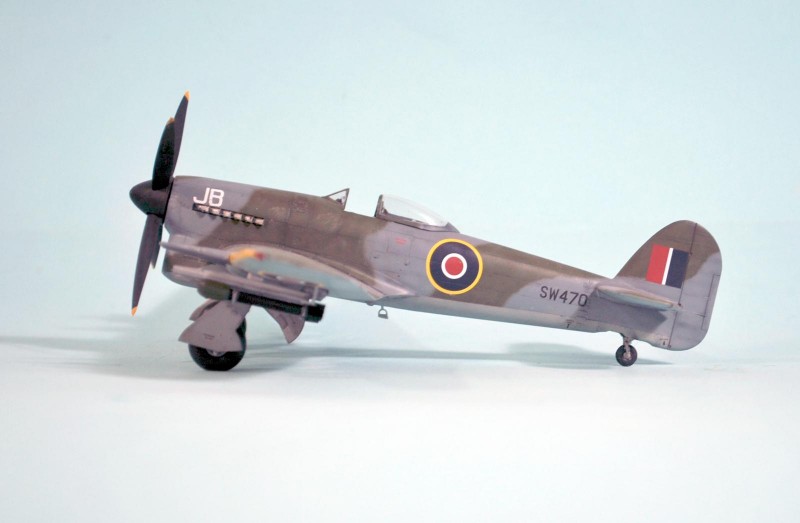
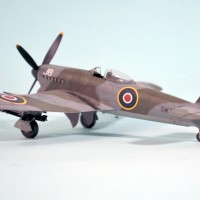
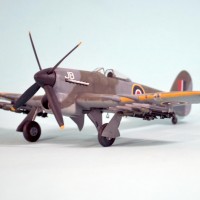

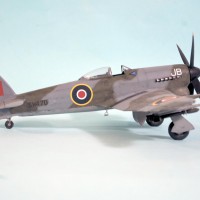
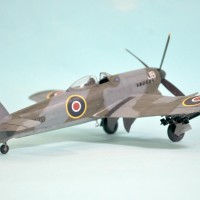
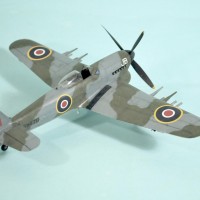
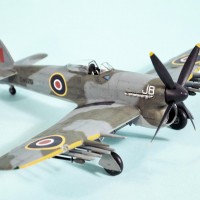
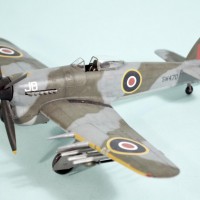
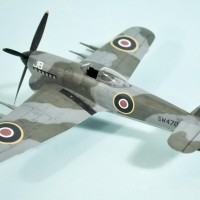
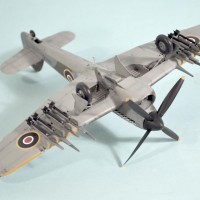

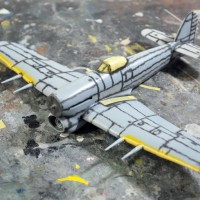
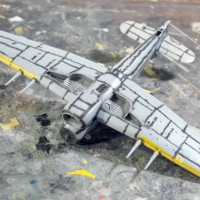
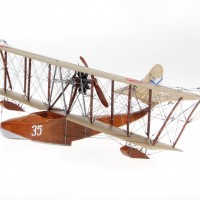
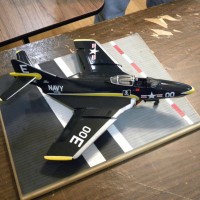

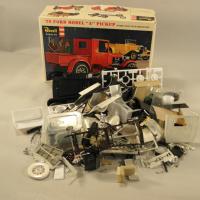
Another great build and really excellent article, Tom!
Wonderful build and ditto article, Tom @tcinla.
I do have the original Hasegawa one in stash and are looking forward to start with it after reading your article.
Looks great, Tom
Lovely Typhoon! Nicely done.
I am not a British plane guy, but I do like the Typhoon. It looks tough and mean with the big scoop under the engine. Your build is good looking and captures the mean look.
@tcinla - yes... another great article and build. You inspired me to pull my Hasegawa Typhoon out the stash and take a look at it and see if I have everything I need to get going. But first, I'm jonesing to jump on that new Eduard Tempest Mk II.
Great work and narrative!
Great history lesson @tcinla! And a very nice scale model result as well! Tom, was Wing Commander Baldwin flying jets when he was lost in Korea?
He was part of the team of RAF pilots who were flying F-86s with the 51st FIW.
Thanks for the additional information TC.